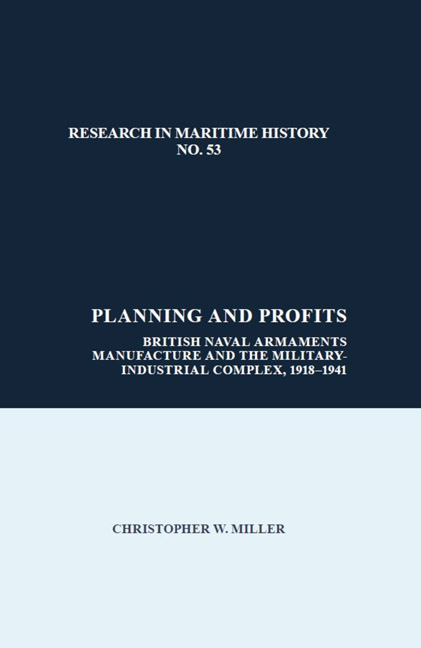 Planning and Profits
Planning and Profits Book contents
- Frontmatter
- Contents
- Acknowledgements
- About the Author
- List of Tables and Figures
- List of Illustrations
- List of Abbreviations
- A Note on Definitions
- Part One Introduction
- 1 “Guilty Men,” Complexes, and Legends
- 2 Structural Changes, from the Ministry of Munitions to the Principal Supply Officers Committee, 1918–1927
- Part Two Industry and the Navy before Manchuria, and the Establishment of the Warshipbuilders’ Committee, 1919–1931
- Part Three The Formation of a National Government, the Far East, and the PSOC Approach to Industry, 1931–1934
- Part Four The Ultimate Potential Enemy and Rearmament Planning, 1934–1936
- Part Five The Inskip Era and War, 1936–1941
- Conclusion and Retrospective
- Appendices
- Bibliography
- Index
1 - “Guilty Men,” Complexes, and Legends
from Part One - Introduction
- Frontmatter
- Contents
- Acknowledgements
- About the Author
- List of Tables and Figures
- List of Illustrations
- List of Abbreviations
- A Note on Definitions
- Part One Introduction
- 1 “Guilty Men,” Complexes, and Legends
- 2 Structural Changes, from the Ministry of Munitions to the Principal Supply Officers Committee, 1918–1927
- Part Two Industry and the Navy before Manchuria, and the Establishment of the Warshipbuilders’ Committee, 1919–1931
- Part Three The Formation of a National Government, the Far East, and the PSOC Approach to Industry, 1931–1934
- Part Four The Ultimate Potential Enemy and Rearmament Planning, 1934–1936
- Part Five The Inskip Era and War, 1936–1941
- Conclusion and Retrospective
- Appendices
- Bibliography
- Index
Summary
When in 1948 Winston Churchill published the first of his six-volume history of the Second World War, The Gathering Storm, he was in no doubt as to how Britain had ended up in such an awful conflict so soon after the Great War of 1914–1918. “How the English-Speaking peoples through their unwisdom, carelessness, and good nature allowed the wicked to rearm” was the theme – and the subtitle – of the book. The Second World War, like the First, had cost the British Empire scarcely imaginable lives and driven it to the brink of bankruptcy. In Churchill's mind, this catastrophe had been avoidable. To him, the blame lay squarely at the feet of “guilty men,” including Conservative Prime Ministers Stanley Baldwin and Neville Chamberlain, for not stamping out Adolf Hitler's belligerence while Nazi Germany remained weak, and with the National Governments of 1931–1935 and 1935–1939 for failing to adequately prepare British defences for a major war despite repeated warnings of impending crisis.
Churchill had, of course, been marginalised by these administrations, and thus settling a political score was no doubt part of his agenda. Less subjective histories in more recent decades have viewed the actions of these “appeasers” in a more sympathetic light. While rarely apologising for them, the severe political and financial constraints under which policymakers operated, including – but not limited to – the economy, industry, and public opinion have become an enduring part of the interwar narrative.
It is often forgotten, however, that during the 1930s an entirely different and mutually contradictory line of thinking developed. The so-called “Merchants of Death” concept argued that shady arms dealers could influence the direction and timing of armed conflict, that Britain and other major powers had uncomfortably close relationships with armament manufacturers for too long, and that private profit in weapons led directly to war. The concept – some would call it a “myth” prompted Royal Commission enquiries, mass petitions with millions of signatures, and even freakish by-election results. Since that point the legend has become bundled with Cold War-era warnings of a “Military-Industrial Complex” and has taken on a life of its own. Today, theories of state-military cooperation retain a powerful allure and have been told and re-told for successive generations of conventional and nuclear weapons.
- Type
- Chapter
- Information
- Planning and ProfitsBritish Naval Armaments Manufacture and the Military-Industrial Complex, 1918–1941, pp. 3 - 8Publisher: Liverpool University PressPrint publication year: 2018
